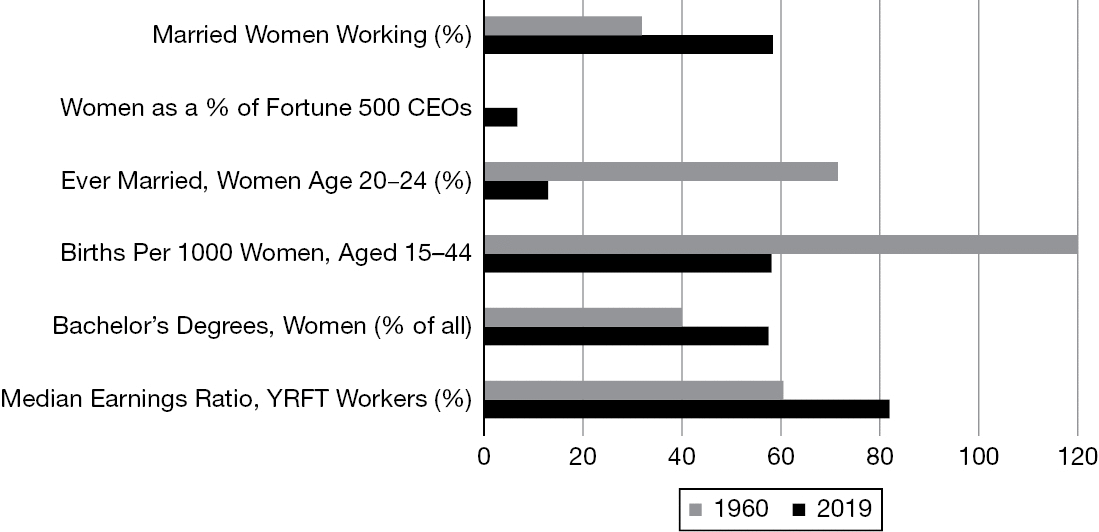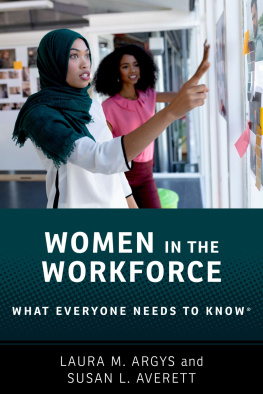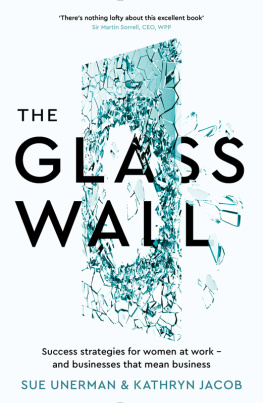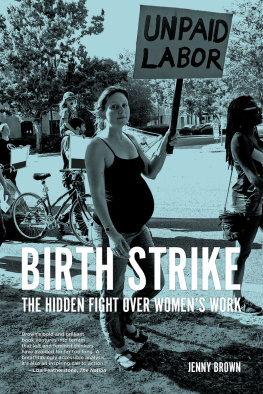WOMEN IN THE WORKFORCE
WHAT EVERYONE NEEDS TO KNOW

Oxford University Press is a department of the University of Oxford. It furthers the Universitys objective of excellence in research, scholarship, and education by publishing worldwide. Oxford is a registered trade mark of Oxford University Press in the UK and certain other countries.
What Everyone Needs to Know is a registered trademark of Oxford University Press.
Published in the United States of America by Oxford University Press
198 Madison Avenue, New York, NY 10016, United States of America.
Oxford University Press 2022
All rights reserved. No part of this publication may be reproduced, stored in a retrieval system, or transmitted, in any form or by any means, without the prior permission in writing of Oxford University Press, or as expressly permitted by law, by license, or under terms agreed with the appropriate reproduction rights organization. Inquiries concerning reproduction outside the scope of the above should be sent to the Rights Department, Oxford University Press, at the address above.
You must not circulate this work in any other form and you must impose this same condition on any acquirer.
Library of Congress Cataloging-in-Publication Data
Names: Argys, Laura M., author. | Averett, Susan L., author.
Title: Women in the workforce : what everyone needs to know /
Laura M. Argys and Susan L. Averett.
Description: New York, NY : Oxford University Press, [2022] |
Series: What everyone needs to know |
Includes bibliographical references and index.
Identifiers: LCCN 2021049853 (print) | LCCN 2021049854 (ebook) |
ISBN 9780190093389 (paperback) | ISBN 9780190093396 (hardback) |
ISBN 9780190093419 (epub)
Subjects: LCSH: WomenEmploymentHistory21st century. |
Married womenEmployment. | Womens rights. | Feminism.
Classification: LCC HD6053.A674 2022 (print) | LCC HD6053 (ebook) |
DDC 331.4dc23/eng/20211117
LC record available at https://lccn.loc.gov/2021049853
LC ebook record available at https://lccn.loc.gov/2021049854
DOI: 10.1093/wentk/9780190093396.001.0001
Contents
The authors met in graduate school and owe sincere thanks to Dr. H. Elizabeth Peters, who served as their advisor and mentor and fostered their interest in womens economic lives. Since that time, the authors have collaborated on dozens of refereed journal articles and book chapters and co-edited (with Saul D. Hoffman) the Oxford Handbook on Women and the Economy (2018). The natural extension of that work was to make this area of research available to a more general audience. The present work represents the authors combined sixty years of experience in the field and reflects the enjoyable and productive nature of their career-long collaboration.
This research is also informed by the authors lived experiences as wives, mothers, and professional women, and they are grateful to their husbands, Richard Argys and Albert Folks, whose unwavering support made this project possible. Thanks are particularly due to Richard Argys, who painstakingly read and edited every word of this book, though the authors take full responsibility for any remaining errors. Exceptional research assistance was provided by Sumini Siyambalapitiya, Fan Guan, and Michael McHenry. The authors would like to thank their OUP team, James Cook and Macey Fairchild. Thanks are also due to the books initial OUP editor, David Pervin, who encouraged the development of this work.
Stories about women in the workforce permeate newspapers, magazines, and virtually all other media formats devoted to news and commentary in contemporary society. Womens movement into the paid workforce has transformed their livesand the lives of their familiesand has in many ways reshaped society. This book takes a holistic view of the economic lives of women in the workforce.
Adam Smith is largely viewed as the father of modern economics. The focus of his theories, as he explained in the Wealth of Nations in 1776, was on paid work in the formal labor market and worker productivity. Since women in that historical period devoted nearly all of their time to unpaid work (what we now term household or caring labor), it is perhaps not surprising that women were a nearly invisible part of economics. Their contributions to home and family were and often remain outside of standard measurements of economic activity.
Womens contributions are invisible no more. Two important changes propelled women into the mainstream of economics. First, when the United States entered World War II, women, particularly married women, surged into the workforce. As women changed their allocation of time from unpaid household work to paid work in the labor market, their labor began to contribute significantly to official measures of the countrys economic production. As women continued to enter the paid workforce, they also began to make inroads as entrepreneurs and leaders.
Second, illustrates many ways in which womens lives changed from 1960 to 2019. The figure shows that women began to marry later in life, have fewer children, and acquire more educationchanges that are consistent with spending a far greater portion of their adult lives working for pay. During this period, women also made inroads into historically male-dominated jobs. Yet, because women usually remain the primary caregivers of children, issues such as work/life balance, equal pay, and the glass ceiling remain at the forefront of policy discussions in the United States and around the world.

Figure I.1 The Transformation in Womens Lives from 1960 to 2019. Source: Adapted from Saul D. Hoffman and Susan L. Averett, 2021. Women and the Economy: Family, Work, and Pay. Red Globe Press.
In large part due to these changes, womens earnings as a percentage of mens increased from 60 percent in 1960 to just over 80 percent in 2019. Most of this change occurred in the 1970s and 1980s; the gender wage differential has not narrowed appreciably in the past twenty years. This book examines the importance of womens participation in the workforce, their contributions to the economy, and the challenges they face in claiming status, influence, and compensation equal to mens.
Economists recognize that many outcomes that lead to gender disparities are the result of choices women make, but that they also reflect constraints faced by women based on social norms and laws. Nearly every chapter of this book considers how expectations of women as primary caretakers of their homes and families hinder their progress in the workplace. As women economists who faced some of these constraints ourselves, we view unfettered choice as a good thing for all women (and men). Hence, we argue that policies that remove barriers and expand opportunities are key components to achieving gender equality. It is important, particularly for policymakers, to understand when disparate outcomes in employment, occupation, and pay, for example, result from a restricted set of options.
This book focuses on what we know from recent and historical research, primarily by economists. What differentiates data analyses performed by economists from those in other social sciences is a focus on identifying and understanding causality. For example, economists want to discern whether advanced education









